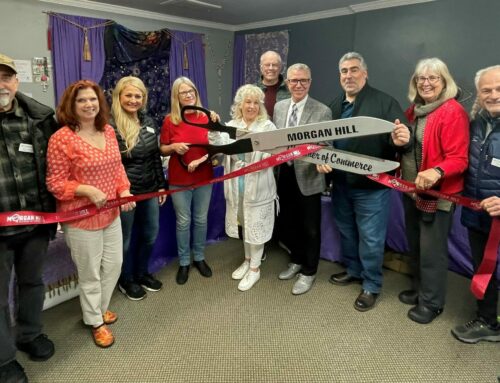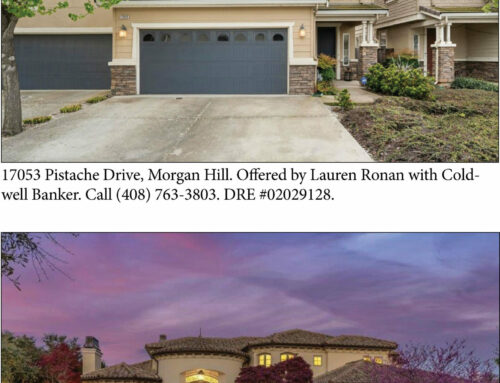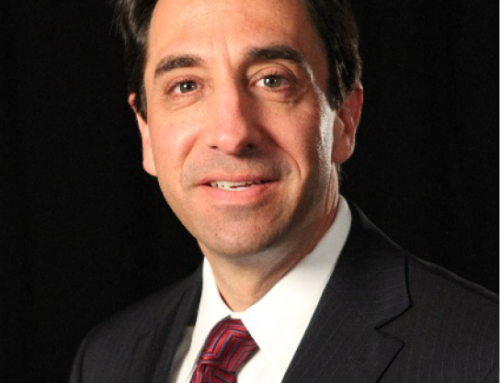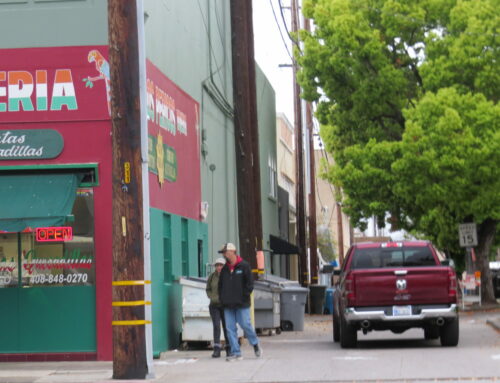City might conduct 6-month pilot program to gauge ‘road diet’ plan’s effect on traffic flow
Published in the Sept. 3-16, 2014 issue of Morgan Hill Life
By Marty Cheek
The future of downtown Morgan Hill’s character is now being shaped as public debate heats up on a controversial proposal to “calm” the flow of traffic along the six blocks of Monterey Street from East Dunne to Main avenues.

Motorists make their way through downtown Morgan Hill during a recent Friday evening commute.
Photo by Marty Cheek
Implementing more efficient ways of moving vehicle traffic can potentially spur economic growth for local restaurants and shops by making Morgan Hill’s downtown district more attractive for pedestrians and cyclists. But some business owners fear reducing Monterey Road from four to two lanes through the downtown might lose them potential customers as motorists use bypass thoroughfares such as Butterfield Boulevard.
Rosy Bergin, co-owner of Rosy’s at the Beach restaurant on Monterey Road, is actively involved with the Morgan Hill Downtown Association and has long been a proponent of calming traffic in the district. She sees potential economic benefits for her restaurant and other businesses if more people visit downtown because there are fewer cars and trucks on Monterey Road with the accompanying noise, pollution and safety concerns.
“If downtown is going to become much more of a destination, we have to create an environment that makes it appealing to be there for pedestrians and shoppers and diners,” she said. “Reducing the lane traffic will definitely do that. It’s just that habits are so hard to change and people are use to barreling downtown to get wherever they’re going. It’s very, very difficult to slow down when you have been driving, like, 35 or 45 miles an hour and you come downtown.”
Not just the safety of pedestrians but cyclists should be considered as Morgan Hill grows as a community advocating pedal power, Bergin said, encouraging the idea of the city providing more downtown parking racks to lock bicycles.

Doug and Chris White relax at Betto’s Bistro with their dog Edgar in downtown Morgan Hill.
Photo by Marty Cheek
“When other people see that there’s a designated bike parking area, they’ll think, ‘Oh, I can just ride my bike downtown,’” she said. “A lot of people live really close to downtown but they don’t consider riding their bikes downtown because there’s not a lot of places to put their bikes.”
Like Bergin, BookSmart co-owner Brad Jones said he is excited about the possible benefits of slowing traffic down and creating a more “human-scale” downtown business corridor. A century or so ago when Morgan Hill was a village, the downtown was built around a two-lane road, he said. As car and 18-wheeler truck traffic increased when the country lane Monterey Road evolved into Highway 101, the buildings were moved back twice to allow for the increasing numbers of vehicles to pass through. Congestion was relieved when Highway 101 moved east, but the psychology of motorists remained that the downtown was a thoroughfare and not necessarily a place for business or dining.
“I think anything that creates a more usable, friendly downtown will benefit everybody in the downtown,” Jones said. “We kind of tout ourselves as the community’s living room, but we have a four-lane highway going through the middle of it. Who in their right mind would plan that? That was never the plan when Monterey Road first started. We want a downtown that’s designed more for humans and less for automobiles. We’re talking about multi-modal transportation where people walk, people bike, people drive their car, but they do that to come downtown and enjoy our downtown.”

VTA bus No. 168 makes its way south on Monterey Road through downtown Morgan Hill.
Photo by Marty Cheek
The idea of revamping downtown traffic flow started in 2007 when developers looked at purchasing Redevelopment Agency property then owned by the city. The global economic downturn the next year and the end of the RDA put downtown plans on hold. As the economy picked up, city staff in 2011 renewed work on renovation of the downtown’s infrastructure so that the district might serve much more as a destination for residents and visitors, said Director of Public Works Karl Bjarke.
The city council on Aug. 6 approved a $65,000 study involving a three-day “tactical urbanism demonstration” traffic flow trial scheduled tentatively for Oct. 24 to 26 to discover what impact reducing lanes and other street changes might have on motorists. Based on data which will be gathered from the test and analyzed by Alta Planning + Design, a civil engineering consulting firm hired by the city for the study, city council members will decide whether or not to proceed on a six-month “road diet” pilot program starting in January. If implemented, this program will help council members decide if downtown traffic flow changes should become permanent.
“The council in a May meeting adopted the Downtown Placemaking Investment Strategy,” Bjarke said. “The purpose was to create a placemaking atmosphere that would help the downtown survive and make it more pedestrian and bicyclist friendly, make it safer for pedestrians to cross the downtown road, and improve the economic viability of the downtown.”
During the past several months, city staff has been conducting public outreach with the residents and businesses that would be impacted by the proposed “complete streets” projects. A weekly placemaking meeting is held Thursday mornings at the Community and Cultural Center for residents and business owners to share their concerns. A special Placemaking Symposium workshop for the public will be held at the same location at noon and at 6 p.m. Sept. 19.
“The downtown business community has been pretty vocal with us about wanting to experiment with us on a trial basis narrowing Monterey Road to one lane (in each direction),” Bjarke said. “Business owners and merchants told us that this is something they’ve been wanting for a long time and they feel now is the time to try narrowing to help achieve this traffic calming because they felt there is too much traffic, it is too loud, and it is inhibiting the pedestrian use of the downtown and inhibiting downtown economic viability.”
While some downtown business people favor reconfiguring the downtown corridor, others are concerned that reducing the vehicle flow might hurt their bottom line.
“I’m absolutely in favor of anything that brings more people and more business to downtown,” said Morgan Hill Cigar Company & Wine Shop co-owner Jeff Burris. “But as I look at the various cities like Gilroy and Campbell and others that have reduced lanes, they’re not picking up more people as a result of it.”
The downtown merchant also shared his concern of what he sees as the possibility of “bottleneck” commute points along intersections bordering downtown as drivers go from four lanes to two. The resulting congestion might spread into surrounding neighborhoods, he said.
Businesses owners on the outside edge of the downtown also fear the prospects of reduced customers if the traffic flow through downtown is restricted and more drivers decide to bypass downtown by taking Butterfield Boulevard, said Marc Minton owner of the NAPA Auto Parts Store located on Monterey Road one block north of Main Avenue.
“My biggest concern is that it’s going to cut my business off from the south end of town and split the town in half,” he said. “You’re going to have south of downtown and north of downtown instead of one city. There’s no access for my store other than from Monterey Road. It’s going to be a tremendous hit on our business if this happens.”
Minton believes the lane reduction test period Oct. 24-26 won’t truly gauge the impact on through traffic. “I don’t know if they can really get a good reading from three days. That’s on the weekend. Well nobody is going to work on the weekend, so that’s not a true picture. This push is from the Downtown Association. I can understand why they like it because this makes it like their own little community. But I think the rest of the town is going to suffer because of it.”
Joshua Mello, a senior associate with Alta Planning, has been talking with business owners and local residents at weekly placemaking meetings to inform them of the city’s plans and learn about their concerns for the proposed re-engineering of downtown traffic. The plan is not to prevent vehicles from using downtown’s Monterey Road to commute but to make traffic flow more effectively, he said.
Commute time through downtown will increase by only “a few seconds” because there will be far less wait time at stoplights if pedestrians can cross a shorter distance. A permanent road reconfiguration is not a “foregone conclusion” by the city, but awaits public input and data from the trial and the possible pilot program, he stressed.
“We’ll be able to look at all the different options during the demonstration and see what works and what doesn’t work, what feels right and what doesn’t feel right,” Mello said. “Our final product from this is going to be a report for the city council that documents what we found from the demo that worked, what we learned, whether there is (public) support or no support, and what we would recommend to use for evaluation measures and performance measures for the pilot if they elect to go forward with the pilot.”
Because of the recent opening of the Butterfield Boulevard bypass leading into Watsonville Road, the timing is right for Morgan Hill to consider whether or not to re-engineer its downtown for people over vehicles, he said.
“A lot of cities miss the opportunity to redirect traffic to a bypass to make their former state highway more pedestrian friendly,” Mello said. “Morgan Hill is well positioned now because you have the chance to make sure Butterfield does its job and carries regional traffic while Monterey does its job where it can serve as the main street of the community where people can shop and dine and recreate and hold events and feel comfortable.”








